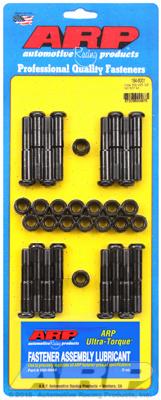Olds 225-307-350-403-425 3/8" Rod Bolt Kit
Unquestionably the most important fasteners in any engine are the connecting rod bolts, as they hold the key to the entire rotating assembly. A broken bolt will lead to catastrophic engine failure. As you can imagine, the most critical joint is where the connecting rod halves mate. The rod bolts must support the primary tension loads caused by each rotation (or cycle) of the crankshaft.
Unquestionably the most important fasteners in any engine are the connecting rod bolts, as they hold the key to the entire rotating assembly. A broken bolt will lead to catastrophic engine failure. As you can imagine, the most critical joint is where the connecting rod halves mate. The rod bolts must support the primary tension loads caused by each rotation (or cycle) of the crankshaft. When the crank rotates, the big end of the connecting rod essentially becomes oval-shaped and the rod bolts bend. As the crankshaft continues to rotate, the rod becomes round again. With alternating tension loads and cyclic bending of the bolts, it is very important to install fasteners that are able to exert a clamping force greater than the load imposed upon the joint (tension).
In addition to utilizing a rod bolt with sufficient strength to withstand the tremendous cyclical strains placed upon it, it is absolutely imperative that the bolts be properly tightened. The preferred method of monitoring the correct amount of tension is through use of a stretch gauge. This is far more accurate than using a torque wrench. Moreover, through subsequently checking the rod bolts length at teardowns, it is possible to determine if it has been stressed beyond safe limits and must be replaced.
A premium grade 8740 alloy chrome moly steel is used to manufacture ARP High Performance connecting rod bolts. This material is heat-treated to provide a tensile strength in the 200,000 psi range, which is substantially stronger than the OEM bolts. Cycle testing shows ARP High Performance rod bolts to be nearly five times more reliable than stock bolts.
